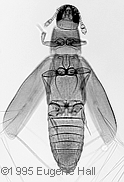
THE XERCES SOCIETY FOR INVERTEBRATE CONSERVATION Aquatic Invertebrates in Pacific Northwest Freshwater Wetlands |
| Identify taxa |
|
Ptiliidae are mostly terrestrial, but may be found in wetland macroinvertebrate samples from the Pacific Northwest. They have been collected in wetlands in Washington. They prefer the margins of small streams as well as a variety of terrestrial habitats, but their minute size makes them difficult to spot. The underwings of the tiny adults are narrow, with a fringe of very long hairs all the way around. When extended, these hairs help the wings function as flotation devices at the water's surface. The larvae are slightly larger than the adults, but are still typically under 2mm long. Larvae are usually eyeless; the body is relatively long with a pair of hooks and a pair of tiny, one-segmented tails at the tip of thr abdomen. Ptiliids produce only one egg at a time and that egg may be as large as half the body length of the female! The photos above were used with permission from Eugene Hall. They are from his website, the Tree of Life (outside link). |
|
Size: xsmall - small Identifying feature(s): larvae with 10 segmented abdomen; eyespots absent, i pair of anal hooks. Adult tarsi 2 or 3 segmented; antennae 11 segmented. The wing consists of a stalk attached to a long membrane bordered with numerous hairs Habitat: larvae are semiaquatic; along stream and river margins; in moist leaves; wetlands. Tolerance to pollutants: unknown |
 |
|
© 2007 Xerces Society
Contact info@xerces.org


